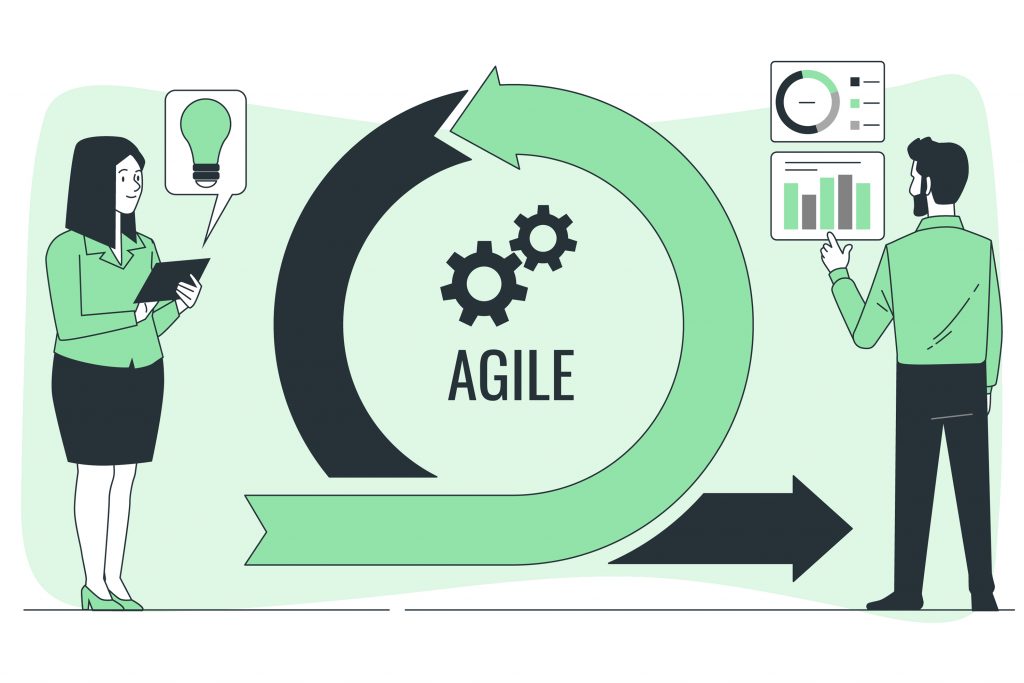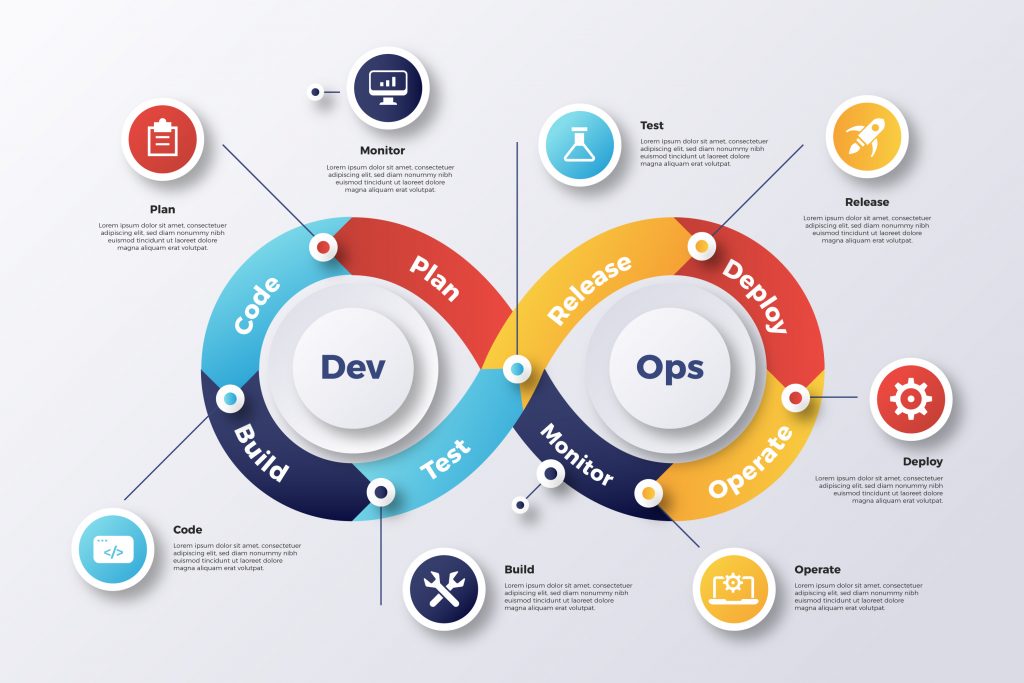In today’s hyperconnected world, businesses of all sizes are increasingly realizing the transformative power of web development. For enterprise-level organizations, the stakes are even higher, and the complexities are greater. This is where enterprise web development steps in, wielding its magic wand to weave a tapestry of innovation, agility, and growth.
Enterprise web development is the strategic planning, design, development, deployment, and maintenance of web applications and web services that support the core business processes of an enterprise. It goes beyond simply creating a website; it encompasses a comprehensive approach to leveraging the power of the internet to achieve organizational goals.
It helps businesses in streamlining operations, Enhancing customer experiences and helps in data-driven decision-making.
Significance of Enterprise Web Development for Businesses
Enterprise web development plays a pivotal role in the success of modern businesses, offering a multitude of benefits that streamline operations, enhance customer experiences, and drive growth.
Streamlining Operations
Enterprise web development can significantly streamline operations and enhance efficiency across an organization by automating tasks, integrating systems, and providing self-service portals. This automation eliminates the need for manual intervention, reducing errors, saving time, and improving overall productivity.
Task Automation:
Enterprise web applications can automate repetitive and time-consuming tasks, such as data entry, order processing, and customer account management. This automation frees up employees to focus on more strategic and value-added activities.
System Integration:
Enterprise web applications can seamlessly integrate with existing business systems, such as ERP (Enterprise Resource Planning) and CRM (Customer Relationship Management) systems. This integration breaks down silos, facilitates data sharing, and streamlines workflows.
Self-Service Portals:
Enterprise web applications can provide self-service portals for employees, customers, and partners. These portals empower users to access information, perform tasks, and resolve issues independently, reducing the burden on IT support and customer service teams.
Enhancing Customer Experiences
Enterprise web development plays a crucial role in creating exceptional customer experiences that foster loyalty, drive retention, and attract new customers.
Personalized Experiences:
Enterprise web applications can leverage user data to create personalized experiences, tailoring content, recommendations, and offers to individual customer preferences. This personalization enhances customer engagement and satisfaction.
Real-Time Support:
Enterprise web applications can provide real-time support through chatbots, live chat, or video conferencing. This instant support addresses customer concerns promptly and effectively, building trust and loyalty.
Seamless Online Transactions:
Enterprise web applications can facilitate seamless online transactions, including secure payment processing, order tracking, and self-service returns. This ease of use enhances the overall customer experience and encourages repeat purchases.
Data-Driven Decision-Making
This enables data-driven decision-making by providing access to valuable insights into customer behavior, market trends, and operational performance.
Data Analytics:
Enterprise web applications can collect, analyze, and visualize data from various sources, providing businesses with a comprehensive understanding of their customers, market dynamics, and internal operations.
Predictive Analytics:
Enterprise web applications can utilize predictive analytics to anticipate customer needs, identify trends, and optimize resource allocation. This proactive approach enables businesses to make informed decisions that drive growth and competitive advantage.
Data-Driven Innovation:
Enterprise web applications can fuel innovation by providing insights into customer preferences, emerging market trends, and untapped opportunities. This data-driven approach fosters the development of new products, services, and business models.
Expanding Reach and Earning Potential
Enterprise web development empowers businesses to expand their reach beyond physical boundaries, tapping into new markets and diversifying revenue streams.
Global Online Presence:
Enterprise web applications enable businesses to create a global online presence, reaching new customers and partners worldwide. This expansion can lead to increased brand awareness, market share, and revenue opportunities.
New Market Segments:
Enterprise web applications facilitate market research and customer segmentation, allowing businesses to identify and target untapped market segments with tailored products, services, and marketing campaigns.
Diversified Income Sources:
Enterprise web development can open up new revenue streams through e-commerce, online advertising, subscription services, and digital product offerings. This diversification reduces reliance on traditional channels and enhances overall financial stability.
Future-Proofing Organizations
Enterprise web development plays a critical role in future-proofing organizations by providing a scalable and adaptable platform for growth and innovation.
Scalability:
Enterprise web applications can scale to accommodate increasing user volume, data storage, and transaction processing, supporting business growth without compromising performance.
Adaptability:
Enterprise web applications can be adapted to evolving market demands, technological advancements, and changing business strategies, ensuring that organizations remain agile and competitive.
Continuous Innovation:
Enterprise web development fosters a culture of continuous innovation, enabling businesses to introduce new products, services, and features quickly and efficiently, staying ahead of the competition in the dynamic digital landscape.
Core Principles of Enterprise Web Development
Strategic Alignment:
- Enterprise web development aligns with the organization’s overall business strategy, ensuring that digital initiatives support the achievement of strategic objectives.
- This alignment ensures that the organization’s web presence is not just a digital storefront but a strategic tool that drives business growth and success.
User-Centric Design:
- Enterprise web development prioritizes user needs and behaviors, creating intuitive, engaging, and accessible web applications that enhance user experiences.
- This user-centric approach puts the needs of the user first, ensuring that the web applications are easy to use, navigate, and understand, leading to increased user satisfaction and loyalty.
Scalability and Performance:
- Enterprise web applications are designed to accommodate increasing user demand, data volume, and transaction processing without compromising performance.
- This scalability ensures that the web applications can handle the growing demands of the organization and its users, providing a seamless and consistent experience even under heavy traffic.
Security and Compliance:
- Enterprise web applications adhere to strict security standards and comply with industry regulations to protect sensitive data and maintain trust.
- This focus on security safeguards the organization’s valuable data, protects its reputation, and ensures compliance with legal and regulatory requirements.
Integration and Interoperability:
- Enterprise web applications integrate seamlessly with existing business systems, enabling seamless data exchange and workflow automation.
- This integration breaks down silos between departments, streamlines operations, and provides a holistic view of the organization’s data, leading to improved efficiency and decision-making.
The Significance of Data-Driven Decision-Making
Make Informed Decisions:
Data analytics provides a clear and objective lens through which businesses can understand customer behavior, market trends, and operational performance. This clarity allows for informed decisions that are aligned with the organization’s strategic goals.
Enhance Customer Experiences:
By understanding customer preferences, patterns, and pain points, businesses can tailor their products, services, and interactions to deliver personalized and engaging customer experiences. This personalization fosters customer loyalty, satisfaction, and retention.
Optimize Operations:
Data analytics can identify inefficiencies, bottlenecks, and areas for improvement within an organization’s operations. By analyzing data from various sources, businesses can streamline processes, reduce costs, and improve overall efficiency.
Gain a Competitive Edge:
Data-driven insights can provide businesses with a competitive advantage by enabling them to identify new market opportunities, adapt to changing customer demands, and develop innovative products and services ahead of the competition.
Enterprise Web Applications: Gateways to Data-Driven Insights
Enterprise web applications play a crucial role in harnessing the power of data analytics by providing the infrastructure and tools to collect, analyze, and visualize data. These web applications can gather data from various sources, including website traffic, customer interactions, sales transactions, and internal operations.
Data Analytics Tools and Techniques
Enterprise web applications utilize a range of data analytics tools and techniques to extract valuable insights from data. These tools include:
Data Warehousing
Data warehouses serve as the backbone of data analytics by providing a centralized repository for storing and managing large volumes of data from disparate sources. This centralized approach offers several benefits:
Data Consolidation:
Data warehouses consolidate data from various systems, eliminating data silos and providing a single source of truth for analysis.
Data Cleansing and Transformation:
Data warehouses cleanse and transform data to ensure consistency, accuracy, and reliability, enabling meaningful analysis.
Data Governance:
Data warehouses enforce data governance policies, ensuring data integrity, security, and access control.
Scalability:
Data warehouses are designed to scale horizontally, accommodating increasing data volumes and user demand.
Data Mining
Data mining techniques uncover hidden patterns, trends, and relationships within data, providing actionable insights that can significantly impact business decisions. These techniques include:
Association Rule Mining:
Association rule mining identifies frequently occurring patterns and associations between items in a dataset, enabling businesses to understand customer behavior, purchase patterns, and market trends.Clustering:
Clustering algorithms group similar data points together, allowing businesses to segment customers, identify target markets, and tailor marketing campaigns.
Classification:
Classification algorithms predict the category or label of new data points based on historical data, enabling businesses to assess customer risk, identify upselling opportunities, and optimize product recommendations.
Business Intelligence (BI)
Business intelligence (BI) tools empower businesses to visualize and analyze data to gain real-time insights and make informed decisions. BI tools provide a range of functionalities, including:
Data Visualization:
BI tools transform data into interactive dashboards, charts, and graphs, enabling users to easily understand trends, patterns, and anomalies.
Real-Time Analytics:
BI tools provide real-time data dashboards, allowing businesses to monitor key performance indicators (KPIs) and make immediate decisions based on up-to-date information.
Self-Service Analytics:
BI tools enable users to explore and analyze data without relying on IT experts, empowering data-driven decision-making across the organization.
Ad-Hoc Reporting:
BI tools allow users to create customized reports on-demand, facilitating data exploration and insights generation.
Predictive Analytics
Predictive analytics utilizes historical data and statistical modeling to forecast future trends and events, enabling proactive decision-making. Predictive analytics techniques include:
Time Series Forecasting:
Time series forecasting predicts future values based on historical trends, enabling businesses to anticipate demand fluctuations, optimize inventory management, and plan for future resource allocation.
Regression Analysis:
Regression analysis identifies the relationship between variables, allowing businesses to predict outcomes based on known factors, such as customer behavior, market conditions, and product performance.
Machine Learning:
Machine learning algorithms can learn from data and make predictions without explicit programming, enabling businesses to develop predictive models for various applications, such as fraud detection, customer churn prediction, and risk assessment.
Impact of Data-Driven Insights on Business Growth
Data-driven insights have a profound impact on business growth and optimization by:
Driving Revenue Growth:
Data-driven insights help businesses identify new market opportunities, target the right customers, and optimize pricing strategies, leading to increased revenue streams.
Improving Operational Efficiency:
By identifying inefficiencies and optimizing processes, businesses can reduce costs, improve productivity, and enhance overall profitability.
Enhancing Customer Satisfaction:
Data-driven insights enable businesses to personalize customer experiences, address customer needs effectively, and foster customer loyalty, leading to increased customer satisfaction and retention.
Gaining a Competitive Edge:
Data-driven insights provide businesses with a competitive advantage by enabling them to innovate faster, adapt to changing market trends, and make informed decisions ahead of the competition.
Methodologies for Enterprise Web Development
Agile Development:

- Agile methodologies, such as Scrum and Kanban, promote iterative development, continuous feedback, and adaptation to changing requirements.
- Agile approaches divide projects into smaller, manageable cycles, allowing for continuous testing, refinement, and adaptation to evolving needs, ensuring that the final product meets the organization’s objectives.
DevOps:

- DevOps practices bridge the gap between development and operations, fostering collaboration and rapid deployment of web applications.
- DevOps breaks down silos between development and operations teams, promoting a shared responsibility for the entire software lifecycle. This collaboration ensures that web applications are deployed quickly, reliably, and securely, minimizing downtime and maximizing user satisfaction.
User Experience (UX) Design:

- UX design methodologies focus on user research, user persona development, and usability testing to create intuitive and user-friendly web interfaces.
- UX design prioritizes the needs and behaviors of the target audience, conducting user research to understand their pain points, expectations, and preferences. This user-centered approach leads to the creation of web applications that are easy to use, navigate, and understand, enhancing user satisfaction and loyalty.
Key Characteristics of Enterprise Web Development
Complexity:
- Enterprise web applications are often complex systems, handling large volumes of data, supporting diverse user groups, and integrating with multiple legacy systems.
- This complexity demands a deep understanding of business processes, data integration, and system security to ensure that the web applications are robust, scalable, and maintainable.
Integration:
- Enterprise web applications integrate seamlessly with existing enterprise systems, such as ERP, CRM, and supply chain management systems, to provide a holistic view of business operations.
- This integration requires a comprehensive understanding of the organization’s IT infrastructure and the ability to design and implement interfaces that enable seamless data exchange and workflow automation.
Security:
- Enterprise web applications adhere to stringent security standards to protect sensitive data, intellectual property, and financial transactions.
- This focus on security demands expertise in data encryption, access control, and vulnerability management to safeguard the organization’s valuable assets and maintain compliance with industry regulations.
Scalability:
- Enterprise web applications are designed to scale horizontally, accommodating increasing user demand, data volume, and transaction processing without compromising performance.
- This scalability requires the use of robust architecture, cloud-based infrastructure, and load balancing techniques to ensure that the web applications can handle the growing demands of the organization without downtime or performance degradation.
Long-Term Support:
- Enterprise web applications require ongoing maintenance, support, and updates to ensure optimal performance, security, and compliance.
- This ongoing support demands a dedicated team of experienced professionals who can provide timely bug fixes, security patches, and feature enhancements to ensure that the web applications remain relevant and aligned with the organization’s evolving needs.
Customer Experience (CX): The Heart of Enterprise Web Development
In today’s competitive landscape, customer experience (CX) has emerged as a key differentiator for businesses. CX encompasses the entire interaction between a customer and an organization, shaping perception and influencing loyalty. Enterprise web applications play a pivotal role in delivering exceptional CX by providing a digital interface that seamlessly guides customers through their interactions with the organization.
Principles for Designing Seamless and Engaging Customer Journeys
Creating seamless and engaging customer journeys through enterprise web applications requires a focus on user-centric design, personalization, and intuitive navigation. Key principles include:
User-Centric Design:
Prioritize user needs and preferences throughout the design process, understanding their pain points, expectations, and desired outcomes.
Personalization:
Tailor the web experience to individual customers, leveraging data analytics to provide relevant content, recommendations, and offers.
Intuitive Navigation:
Design a clear and intuitive user interface that is easy to navigate, ensuring that customers can find the information and services they need quickly and effortlessly.
Mobile-First Approach:
Optimize the web experience for mobile devices, recognizing the increasing prevalence of smartphone usage.
Accessibility:
Ensure that the web applications are accessible to all users, including those with disabilities, adhering to accessibility guidelines.
Personalization, Real-Time Support, and Self-Service Portals: Elevating CX
Personalization, real-time support, and self-service portals are key enablers of exceptional CX:
Personalization:
Personalized experiences foster customer engagement and satisfaction by catering to individual preferences. Recommendations, tailored content, and personalized interactions enhance the overall experience.
Real-Time Support:
Real-time support provides immediate assistance to customers, addressing their concerns promptly and effectively. Chatbots, live chat, and video conferencing offer convenient and responsive support channels.
Self-Service Portals:
Self-service portals empower customers to manage their accounts, track orders, access knowledge bases, and resolve issues independently. This self-reliance reduces the burden on support teams and enhances customer satisfaction.
Enterprise Web Applications Transforming CX
Amazon: Redefining E-commerce CX
Amazon has revolutionized e-commerce CX through its personalized recommendations, intuitive search function, and seamless checkout process.
Personalized Recommendations:
Amazon’s recommendation engine utilizes customer data and purchase history to suggest relevant products, enhancing the shopping experience and increasing the likelihood of additional purchases.
Intuitive Search Function:
Amazon’s search function is powered by advanced algorithms that understand natural language and user intent, allowing customers to easily find the products they seek, even with vague or incomplete queries.
Seamless Checkout Process:
Amazon’s checkout process is streamlined and secure, minimizing friction and encouraging impulse purchases. One-click ordering, saved payment information, and multiple shipping options make the checkout experience effortless and convenient.
Netflix: Personalized Entertainment CX
Netflix has transformed entertainment CX through its personalized movie and TV show recommendations, user-friendly interface, and continuous innovation.
Personalized Recommendations:
Netflix’s recommendation engine analyzes customer viewing habits and preferences to suggest personalized content, ensuring that users discover movies and shows that align with their tastes.
User-Friendly Interface:
Netflix’s interface is intuitive and easy to navigate, allowing users to quickly browse, search, and select content. The interface is consistent across various devices, providing a seamless user experience.
Continuous Innovation:
Netflix constantly innovates and introduces new features, such as interactive storytelling, curated collections, and social media integration, keeping users engaged and enhancing the overall entertainment experience.
Airbnb: Transforming Travel CX
Airbnb has revolutionized travel CX through its personalized home recommendations, secure payment system, and user-centric design.
Personalized Home Recommendations:
Airbnb’s algorithm suggests personalized home listings based on user preferences, travel goals, and past bookings, ensuring that travelers find accommodations that match their needs and desires.Secure Payment System:
Airbnb’s payment system utilizes advanced security measures and fraud protection, providing peace of mind for both travelers and hosts.
User-Centric Design:
Airbnb’s platform is designed with the user in mind, offering detailed property listings, user-friendly booking processes, and comprehensive communication tools for seamless interactions between hosts and guests.
PayPal: Enhancing Online Transaction CX
PayPal has transformed online transaction CX through its secure payment processing, user-friendly interface, and global reach.
Secure Payment Processing:
PayPal’s payment gateway employs robust encryption and fraud detection mechanisms, protecting sensitive financial information and safeguarding transactions.
User-Friendly Interface:
PayPal’s interface is intuitive and easy to navigate, allowing users to send and receive payments, manage accounts, and track transactions effortlessly.
Global Reach:
PayPal’s global presence and support for multiple currencies enable seamless cross-border transactions, expanding opportunities for businesses and individuals worldwide.
Zendesk: Elevating Customer Support CX
Zendesk has empowered businesses to provide seamless, personalized support across multiple channels, elevating customer support CX.
Comprehensive Support Platform:
Zendesk’s platform provides a centralized hub for managing customer interactions across various channels, including email, phone, chat, and social media.
Personalized Support Experiences:
Zendesk enables businesses to tailor support interactions to individual customers, accessing customer history, preferences, and past interactions.
Real-Time Collaboration:
Zendesk facilitates real-time collaboration among support agents, enabling efficient issue resolution and knowledge sharing.
Summary Highlights
In conclusion, enterprise web development has revolutionized the way businesses interact with their customers, transforming CX and driving growth. By leveraging data analytics, personalization, and user-centric design, businesses can create seamless and engaging customer journeys that foster loyalty, enhance satisfaction, and propel success.
GeekyAnts, a leading provider of web and app development services, empowers businesses to harness the transformative power of enterprise web development. With a team of experienced developers and a deep understanding of CX principles, GeekyAnts helps businesses create innovative and effective web applications that deliver exceptional customer experiences.
If you’re looking to elevate your CX and reap the benefits of enterprise web development, GeekyAnts is your trusted partner. Contact us today to explore how we can help you transform your digital presence and achieve your business goals.


















